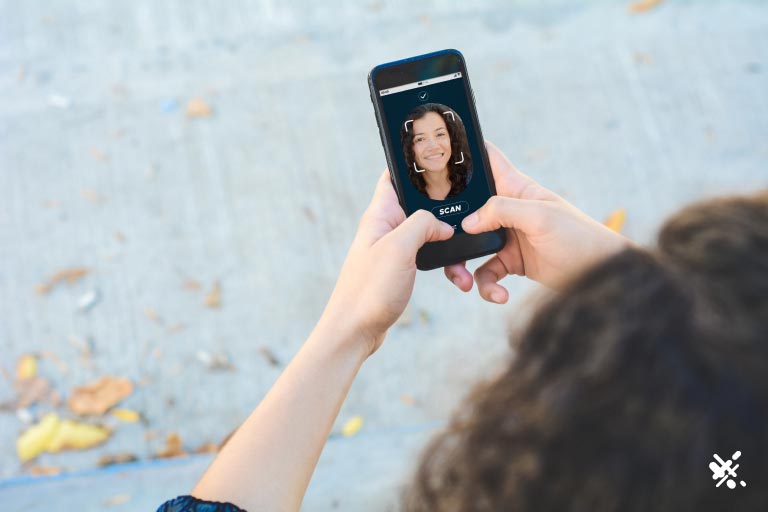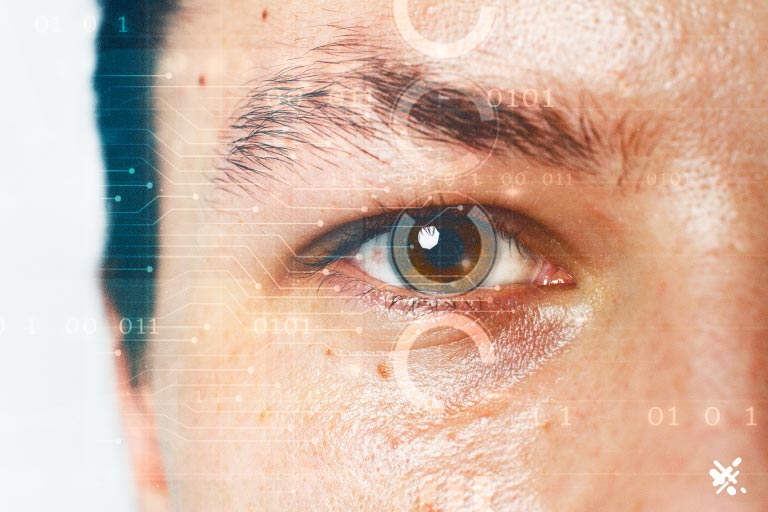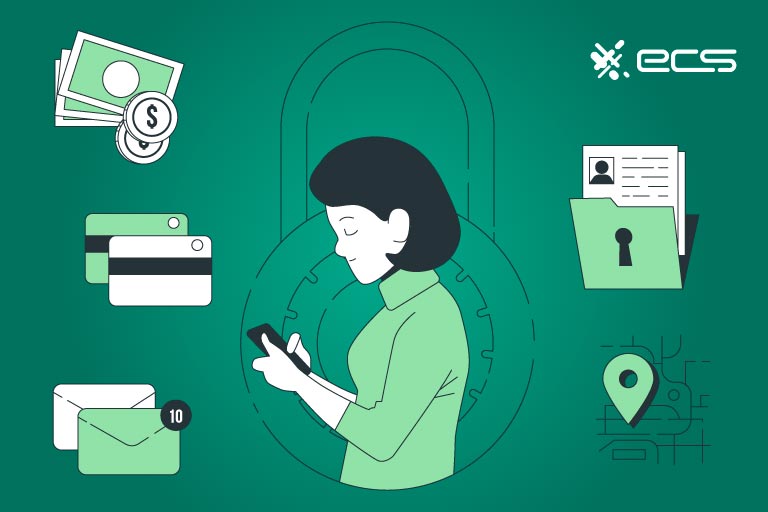Smile! You’re on camera. The future of payment authentication is here—and it’s all about biometrics in payments. Biometric payment companies will join established players in the credit card landscape to redefine the payment experience. And biometric technology may be the ultimate level of security, in addition to facilitating easy, quick payments.
It’s easy to see things like voice recognition and fingerprint sensors as invaders to the payment ecosystem. But when viewed in the context of fintech’s evolution, fingerprint payments are the next step in payment processing.
Remember that until about 70 years ago, plastic credit and debit cards did not exist. These newfangled pieces of technology changed the behavioral characteristics of retail shopping forever. And the first cards did not have magnetic strips or EMV chips. They had embossed numbers that carbon copy paper would capture information from.
These days, we take for granted the idea of waving a contactless card over a payment terminal. Before that, we didn’t think twice about inserting an EMV chip. And before that, swiping a magnetic strip was just a routine part of shopping. But all these things were new at some point.
A Short History of Biometrics
Modern-day biometrics first made their appearance in the realm of high-security clearance and law enforcement. Things like DNA sampling took the guesswork out of who-done-it. Fingerprint scanners helped identify individuals worthy of accessing whatever the government is hiding in places like Area 51 (probably not your grandma’s chili recipe).
The idea of using biometric payment solutions in consumer-facing retail settings didn’t occur to anyone except select futurists. For one thing, biometric sensors were costly pieces of technology, which limited biometric authentication to agencies with big budgets.
Another hurdle was the issue of how exactly to rapidly analyze biometric data at the point of sale. But there’s been a rapid advance in technology—hardware and software—in the last few decades. Biometric devices are far easier to integrate into existing hardware, like smartphones.

Facial Recognition with Apple Pay
Apple Pay and Samsung Pay are making facial recognition commonplace. It is estimated that such solutions will be implemented on 800 million devices by 2025. Apple is quite humble about this technology, stating it’s facilitated by some of the most advanced software and hardware they’ve ever created. What else can you expect from a company whose logo depicts a bite out of the forbidden fruit?
A TrueDepth camera on the latest iPhone models projects thousands of infrared points of light onto your face. These points are then analyzed to create a topographical map of your features. A bionic chip inside the phone then compares that data to an enrolled facial scan.
This of course means that Apple users need to register their face. A user can complete facial registration during the setup of the phone, or at any time by accessing the settings. But what if your face looks different after registration…like, for instance, everyone who wore masks during the Covid pandemic?
Believe it or not, Face ID is able to recognize and adapt to changes in your visage, such as makeup or facial hair. If there has been a significant change to your appearance, like cleaning up after no-shave November, the system will update your facial data after you input your passcode.
One in a Million
To be fair, Apple estimates there is a one in one million chance that someone could use their face to bypass your Face ID. The upshot of this statistic is that your twin (if you don’t already have one) is out there, somewhere (cue the Twilight Zone theme music). But the odds of seeing Sasquatch, Elvis, or a UFO are more likely.
As such, Face ID is a secure way to lock unwanted persons out of your phone. After scanning your face and verifying the biometric identifiers, you can access your mobile wallet and use it to make a contactless payment at the point of sale or when shopping online.
Mastercard’s Brazilian Biometric Scan Pilot Program
Mastercard rolled out a facial recognition pilot in 2022 in the Ibirapuera Park neighborhood in São Paulo, Brazil. It’s a trendy neighborhood of upwardly-mobile young 20 and 30 year olds.
The location choice was largely due to the fact some of the pioneers of facial recognition paymentech are Brazilian natives. Payface, a Brazil-based biometric tech company, has been working closely with Mastercard to roll out the technology.
Their first customer was a chain of convenience stores, where joggers would frequent for items like bottled beverages and snacks. It makes sense, juggling keys and wallets is difficult while jogging. Unless, you’re wearing a fanny pack. And most joggers would rather not-though they are making a comeback in the fashion trends. Now, joggers can run in and out of the store with their purchase only using their face.
Positive Response for Mastercard Facial Recognition
Because, a smartphone or tablet can process biometric scans, no specific POS hardware is needed. For a smoother customer experience, a stand can hold the device in place at the point of sale, ready to greet smiling shoppers as they checkout. Integrating biometrics with loyalty offers and points can enhance the system even further.
Just like Apple’s Face ID, users must register their face with Mastercard via an app on their phone. The response was positive. Around 1,000 consumers registered for facial recognition-three times more than expected.
The average consumer used facial recognition tech to make six purchases over a three-month period. Of 100 participants surveyed, 90% were comfortable with the idea, and 76% liked it so much they’d recommend it to a friend.
Mastercard is optimistic about the technology, which also received positive responses from retailers. The process of facial recognition to complete payments is much faster than plastic cards, or even mobile wallets. The end result is faster-moving lines and greater in-store efficiency. Mastercard is rolling out the pilot technology in other markets around the United States, the Middle East, and Asia.
Fingerprint Biometric Payment Systems
Another common modality is the biometric fingerprint payment system. Apple started rolling this out to consumers in 2013, with iPhone 5S. Consumers could use their fingerprints to unlock certain applications on the phone, including their mobile wallet. Because each finger has its own unique print, nobody can replicate yours. Even your twin.
How Does Biometric Authentication Work On Your Phone?
However, fingerprinting technology has gone through several iterations to avoid fraud. As smartphone manufacturers roll out successive models of hardware to consumers, they are changing the modality of conducting fingerprint scans.
The oldest method of fingerprint scanning is purely optical, using a miniature camera (like that on your smartphone). Unfortunately, it is possible to fool optical scanners with a good photo.
This prompted the next iteration of fingerprint scanning: a capacitive fingerprint sensor. This sensor discharges electric signals at the points where your skin actually touches the scanning surface, creating a map of ridges and valleys.
The third generation of fingerprint scanning is ultrasonic. In this method, the device sends out small soundwaves to bounce against the surface of your fingerprint, mapping out ridges and valleys based on how quickly the soundwaves return. It’s similar to the echolocation used by bats, dolphins, and Bubbles from the Powerpuff Girls.
As fingerprint recognition gets more common as a method for unlocking applications and making payments, the technology improves. Although optical scans left a slim possibility for identity theft with a photograph, this won’t work with an ultrasonic fingerprint scanner. The end result is a method of making payments that is more secure than entering PINs.
The Visa and Mastercard Biometric Cards
So far, many of the biometrics we’ve discussed are tied to a smartphone or a payment terminal. But what about those consumers who still like to pay with actual plastic? And what about business owners afraid of having to purchase biometric hardware?
As we saw above with facial recognition, a phone or tablet can facilitate payments. But what about fingerprinting? Does that require any specialized hardware? And what about consumer preferences for contactless payments?
After the Covid pandemic, the idea of touching a terminal graced by the fingers of thousands of other shoppers is unappealing. That’s where biometric credit cards come into play, like the Mastercard Biometric Card.
This card has an embedded sensor that can collect fingerprint data, matching the fingerprint to a stored digital template within the card. If the prints match up, the transaction can be completed in a contactless manner or by inserting the EMV chip.
If the fingerprints do not match up (say the wife has asked you to pick up some milk and eggs using her card), the cardholder can still use a PIN number to complete the payment. However, the fingerprint matchup is an additional layer of security. And in some cases, the card network may decline the transaction based on their fraud analysis.
Do Merchants Need a Special POS for Mastercard Fingerprint Cards?
There’s nothing the merchant needs to do differently, because the same POS terminal that accepts EMV chips and contactless payments will accept these biometric fingerprint cards. The card conducts all fingerprint analysis while the consumer holds it as that their thumb touches the indicated spot on the card.
Mastercard’s biometric card is in-house (meaning, Mastercard is the issuing bank). But Visa is also rolling out biometric cards in partnership with issuers Bank of Cyprus and Mountain America Credit Union. Both the Visa and Mastercard cards do not require a battery, and get a boost-up from the POS terminal itself to complete the fingerprint verification.

Don’t Blink: Retinal Scans, Payment, and Banking
Retinal scans may be a big part of future fintech. Retinal scans relate to the iris, which is the colored part of your eye surrounding your pupil. To get more technical, they actually scan the back of the eye…but who’s looking at the difference?
That’s why this type of biometric scan is also called iris recognition. One country at the forefront of using retinal technology is Poland. Polish computer retail chain Komputronik partnered with PayEye in 2022 to roll out point-of-sale eye scanners. Customers of Komputronik can now pay by an eye scan instead of with card or cash.
In the United States, fintech company GalvanEyes has partnered with Florida’s Axiom Bank to roll out a retinal scan device for banking authentication. Eye scans (and other forms of biometric verification) may be quick to take off in the real of consumer-facing retail banking.
That’s because remembering passwords is often a pain point for consumers. Even for consumers that know their passwords, typing them in takes up more time and effort than proffering biometric keys like a fingerprint, face scan, or eyeball.
Do Biometric Payments Have Drawbacks?
One concern consumers might have is whether or not biometric collection is dangerous. The idea of light beams being shot into your eyeball, or electric waves sent into your thumb, is not so appealing. However, these technologies pose no harm.
There is nothing radioactive, carcinogenic, or injurious about the methods used to conduct scans. Of course, never say never, they say.
However, even if they are 100% safe, consumer perception may impede the rollout of these technologies. The process of collecting biometric data may make consumers feel uncomfortable.
While offering a fingerprint may not deter them, they may find facial or retinal scans invasive. Some may even be concerned that the machine collecting biometric data will learn what they did last summer.
Joking aside, consumer sentiment can have serious impacts on retail performance. Marketing experts know that consumer choices are driven by emotion, probably more so than reason. Many people are self-conscious about the way they look and do not like to be photographed by surprise. Presenting customers with a facial scan payment option as the only choice may create negative customer experiences at the point of sale.
For this reason, merchants who are eager to adopt new technologies should not make them the exclusive payment option. Consumers like to feel in control of retail interactions, and one aspect of that interaction is payment.
On a related note, preferred payment methods are often generational. Not every consumer will want to pay with biometric data. Not every consumer will want to pay with a mobile wallet. And not every consumer wants to pay with actual plastic.

Safe Storage of Biometric Data
One concern consumers might have about biometric payments is how the information is stored. Ironically the generation that loves to upload pictures of their bachelorette party to Facebook is weary about their photos getting into the wrong hands.
This concern is justified. Some Americans became concerned about the rollout of a photo database meant to assist law enforcement in multiple states to fight ID fraud. As it turns out, some officers were using the database for personal reasons. Hey babe…hope you don’t mind….I tracked you down with your license plate number and this photographic database. I’ve got handcuffs (wink, wink).
Consumers should have less cause for concern with biometric data stored by financial institutions. Companies that process payment information have moved toward encrypting and tokenizing pieces of information that are used for verification. These methods essentially scramble information into useless symbols that can only be unlocked with a key.
The transfer of information (e.g. comparing registered biometrics to your face or fingerprint) is conducted automatically by hardware or software—not manually by live people. Outsiders are also unable to steal the data because they don’t have the means to unscramble the code that obscures it. Ultimately, the storage of biometric data for payment is very safe.
Some consumers have broader concerns about using biometrics and a digital financial landscape being leveraged by non-financial parties, like…the government.
They picture a dystopian universe where you keep trying to buy cigarettes at a convenience store with your face, but Uncle Sam has determined that you’ve already exceeded your cigarette quota for the month.
It will be interesting to see how voter and consumer sentiments blend to impact the development of the biometric payment climate. But that’s an article for another day.
Biometric Identifiers in the Metaverse
Another interesting sphere in the works is payment in the metaverse. The metaverse is not an actual physical place. Rather, it’s a loose conglomerate of virtual reality worlds built by the likes of Facebook and similar tech companies. In fact, Facebook is so optimistic about this universe through the looking glass, they literally renamed themselves Meta.
Consumers mostly use these worlds for gaming, socialization, and some eCommerce. However, they may see increasing usage for business, education, and other purposes. For instance, trade shows can be conducted where all participants have a digital avatar. And students can take field trips to ancient Rome, or other such places where people wore bedsheets to work.
The metaverse is growing in the retail sphere as well. Consumers can purchase digital items for use in this metaverse. Popular examples include unique gaming skins (for characters), or even digital real estate.
But now, key retailers are entering the digital main street as well. Companies like Walmart and Lowes are opening their digital doors to shoppers. Imagine popping into a Roblox version of Walmart (it’s kind of like a world made out of Lego bricks).
You walk around the aisles, picking out some toilet paper and pickled chile peppers (we had to make this get weird). You go to check out so these tangible, real-world items can be delivered to your door in one hour.
Now it’s time to pay. But instead of having to remove your VR goggles to grab a credit card, you simply step toward the digital register and proffer your eyeball. Your VR headset scans your retina, and the payment is complete—all in the metaverse.
Later that night, you put some pickled chili peppers on your microwave pizza. And the toilet paper comes in handy too.
Biometrics Will Redefine the Payment Experience
That’s the future of biometric payments. Bizarre, but kind of fascinating at the same time.
Returning to the real world, there is also a discussion of embedding payment chips inside of consumers’ bodies. Though, this really isn’t new, if you’ve read the prophecies of the Bible. In 2022, European companies started experimenting with a biochip rollout. Chipped consumers can wave their hand over a POS terminal to complete their payments. They don’t need a plastic card, and they don’t even need a phone.
As you can see, biometric payments are an exciting (and some would even say scary) development in the payment landscape. And given the tendencies toward streamlining the payment process, it seems likely they will soon play a major part. While some of these programs will not require new hardware on your end, there may be hardware, software, and integrations that are needed.
A good payment processor will keep up with these technology trends. They’ll lease and service the most up-to-date equipment. That way, you can provide your customers with the payment process they expect.
If you have any questions about accepting biometric payments, or any questions about payment processing in general, contact us. We’d love to hear from you if you give us a call or fill out our contact form.
